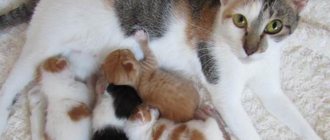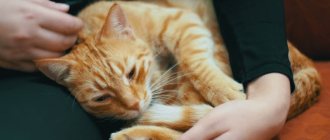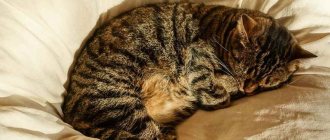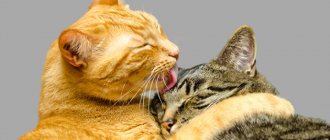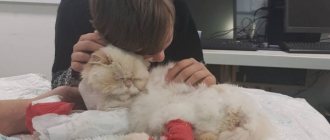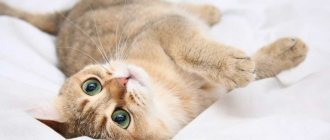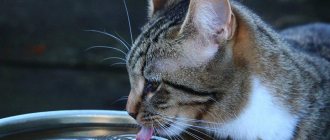How to tell if your cat is ready to give birth
The age of puberty in cats depends on the breed. Breeding cats and representatives of artificially bred breeds usually mature later. Kittens taken from the street, or having a “yard” pedigree, may mature earlier.
The first estrus (scientific name - estrus) indicates readiness to bear offspring. This phenomenon means that the animal is ready to mate with a cat and procreate.
Typically, the dog comes into heat between 6 and 12 months of age. In cats of the British and Persian breeds, estrus may begin later - at the age of 14-18 months.
The pet's behavior changes dramatically, the following symptoms are observed::
- The cat begins to “yell” loudly.
- Her tail is constantly in a vertical position.
- Continuously rub against furniture or the owners' feet.
- The animal's appetite may noticeably decrease.
- Sometimes increased aggressiveness appears.
This behavior is completely normal, the symptoms will go away with the end of the heat. Estrus lasts on average 2 weeks.
How often can a cat give birth?
According to its physiology and natural instincts, a cat’s body is adapted to give birth 3-4 times a year. But some pet owners believe that such a regime depletes the cat’s body and is harmful.
The reproductive system of these representatives of the fauna is very different from the human one. A cat does not have “critical days” like women, and she does not have menopause. Each heat indicates the body’s full readiness to conceive offspring.
Wild animals can mate to their heart's content. But how often a domestic cat gives birth is usually decided by the owner .
A survey of experienced breeders and veterinarians on the topic of how often a cat can be bred without harm to its body gives a clear answer - a healthy cat can give birth as many times as the number of times she goes into estrus.
If the cat was bred for commercial purposes and gives birth frequently, it must be well fed with special food, given vitamins and carefully monitor its health by regularly seeing a veterinarian.
How many times can a cat give birth?
It is widely believed that a cat can give birth four times a year . Is it so? After all, this statement worries many, even to the point of intending to get a cat if there are no plans to breed kittens. There really won't be a simple answer.
Veterinarians advise mating at least once a year, and preferably twice . Cat lovers clubs generally draw up a mating plan , taking into account various factors that affect the cat.
Naturally, giving birth to a cat is a tedious procedure. But empty estrus, when there is no fertilization, also provokes some diseases . So in general, both pregnancy and childbirth should be just in moderation. If the cat eats well and is in good health, then you can breed even more times. The main thing is that the kittens are strong and viable.
If children are born with a pathology, and the birth itself takes place at risk to life, then the animal must be sterilized or special drugs must be used to suppress sexual desire. For example, “Knitting-minus”. If you still want to ensure mating 3-4 times a year, then after giving birth you need to help the animal recover . This can be done by adding vitamins to the food .
Until what age can a cat give birth?
In nature, cats give birth until the age when they are completely in estrus. And it ends by the age of 18-20 years of the animal’s life. In wild and outdoor conditions, most cats simply do not live to that age.
Although the reproductive system works for a long time in cats, after 8-10 years the offspring may be born sick and weak. Everything is individual and there are cases when a cat gave birth to wonderful healthy kittens at the age of 15. But still, veterinarians recommend not breeding your pet after 10 years of age. The risk of kittens having pathologies increases every year.
How often can a cat give birth without harm to her health?
Optimally – 1-2 times a year (mating through estrus). At the same time, to suppress sexual desire, use only non-hormonal (!) drugs, herbal sedatives: Cat Bayun, Mating-minus, Stop-stress (in no case Ex, Sex-barrier, Contrasex, etc.).
My mother has a cat who is already 15 years old. Every year she has 2-3 litters of kittens, we learn about them from the squeak in the box, she always gives birth on her own, without any problems. And my sister, during her first birth, had a large fetus that could not come out, it’s good that everyone was at home, they took the cat to the veterinary clinic, she was sterilized, something went wrong there. So it’s not necessary once in a while. Probably, if in doubt, show the pregnant cat to the veterinarian, and do not leave her alone at the time of the expected birth.
After all, cats are fertile animals, but childbirth undermines their health. Especially purebred cats. After all, there are many artificially bred breeds that are responsive to loads and stress. And pregnancy and childbirth are stressful for any animal. Look at your pet's coat and skin condition during pregnancy; this is an indicator of its health. For example, during my cat’s first pregnancy, her fur fell out in clumps, and there were even bald spots on the animal’s body. A couple of weeks after giving birth, the fur began to improve. From personal observations I can say that sterilized cats live longer.
Apparently, it is not possible for humans to regulate the process and frequency of cat birth; cats themselves know when it’s time for them. My beauty lived completely calmly for five years, without any partying, then one day she brought it. And away we go, we have births every year. Then there was a lull for several years, the raft again. But this is still divine, for some several times a year.
Birth rate and its impact on health
In the absence of control over mating on the part of the owners, cats give birth frequently. On average, a cat can give birth 2 to 4 times a year. Maximum - 5 times a year. The high frequency of births and the lack of a normal period of time between pregnancies negatively affect the health of furry mothers.
Often, cats that give birth have an exhausted body that does not have time to recover and turns out to be susceptible to various types of infections. An animal can lose a lot of weight, develop a curvature of the spine, and acquire pathologies of the nervous system, respiratory tract, and reproductive organs. Hepatitis and necrosis are possible in cats. In general, continuous pregnancies and childbirth lead to a general deterioration in health, rapid aging of the body, and a reduction in life expectancy.
How many litters can you get per year without harming your cat's health?
Among experienced breeders and simply lovers of fluffy beauties, there is no consensus on the question of how many times a cat gives birth a year. Some owners believe that every heat should end in childbirth, others insist that it is better for an animal to give birth no more than once a year. Nevertheless, the frequency of births affects the health of the pet and its life expectancy, and this issue must be approached responsibly.
How many kittens does a cat bear?
To have an idea of the frequency of births in a cat, their impact on the health of the animal, you need to know how long pregnancy lasts, the number of possible heats per year and other issues related to breeding.
The average duration of the period from conception to birth is 9 weeks. This time may shift forward or backward by 3 to 4 days.
It is important for the owner to have an idea of how many days the cat will lamb after mating. In some individuals, gestation of the offspring can take 60 - 70 days. The duration of pregnancy depends on the breed of the animal. Thus, British cats bear offspring for an average of 65 days, Scottish cats - up to 71 days. Maine Coon animals bear cubs for an average of 63 - 68 days. But Sphynx cats spend about 63 days pregnant.
The duration of gestation also depends on the length of the fur coat of the furry pet. The trend is that short-haired beauties give birth 5 to 7 days earlier than their long-haired relatives.
The duration of gestation is influenced by many factors, including the number of offspring. Moreover, the more cubs in the mother’s womb, the shorter their gestation period may be.
During pregnancy, a cat expends significantly more energy and nutrients than usual. In the first 30 days of pregnancy, hormonal changes occur in the mother's body, embryos quickly form and grow rapidly. The mother's body needs complete and high-calorie nutrition.
From the 4th to the 6th week of pregnancy, the most intensive consumption of proteins, fats and carbohydrates occurs by the growing offspring. Kittens require not only energy expenditure, but also mineral reserves.
This period greatly undermines the cat’s health, especially if there are errors in feeding and maintenance.
From about 40 to 50 days, an equally difficult period for the animal begins. At this stage, the cubs’ excretory system begins to function, and metabolic products negatively affect the mother’s body.
Thus, it is not possible to answer unambiguously the question of how long it will take for a cat to lamb. On average, a pet bears its offspring for 60 - 70 days, and this process is associated with a health burden. Every owner of a furry beauty expecting cubs should know about this.
We recommend reading the article on how to deliver a cat. From it you will learn how to prepare for the birth of your pet, about the signs of lambing, and how to help the animal at this difficult moment.
Reproductive age
In order for a beloved animal to delight with its presence for as long as possible, the owner must understand that the cat’s reproductive age must be limited. A young female should be mated no earlier than 7–8 months, and a purebred female should be mated even later, at the age of 1–1.5 years. By this point, 2-3 heats will have passed, the hormonal status will reach the optimal level, the animal will become physically stronger, and the psyche will become resistant to stress. Pregnancy, childbirth, and feeding newborns do not pass without leaving a mark on the cat’s physical condition, so you should not breed her during her first heat.
The duration of reproductive age is a very individual indicator. Some individuals retain the ability for fertilization, normal gestation and childbirth without complications for 15 to 20 years. But this is rather an exception to the rule. Most animals accumulate health problems as they age, and pregnancy and childbirth aggravate the situation.
However, a cat continues to go into heat throughout her life, but the interval between them increases. Therefore, the animal retains the ability to fertilize and can give birth until a very old age.
What to do if your cat is kittening at an advanced age? Experienced and responsible breeders recommend finishing the reproductive function of a pet at the age of 7-8 years and removing it from breeding. By this age, the genetic load increases, the likelihood of obtaining low-quality offspring appears, and the chance of complications increases sharply. If an animal is not valuable for breeding work, it is advisable to castrate it and not subject it to unnecessary testing.
Number of heats per year
Estrus in an animal is a natural and individual process for each individual. The duration of estrus and the frequency of cycles per year depend on a number of factors:
- hereditary characteristics;
- features of keeping (presence of a male);
The average duration of estrus is 1 - 2 weeks, sometimes the process can drag on for up to 3 weeks. The period consists of proestrus (preparation for mating). At this moment, the cat’s body is preparing for the upcoming fertilization: the external genitalia swell, the hormonal status and behavior of the pet changes, it becomes more affectionate and sociable.
After 1 - 3 days, the estrus (estrus) phase begins. This period is characterized by the characteristic behavior of the animal. The cat screams loudly, loses its appetite, tries to leave the room, leaves marks on furniture and objects, and takes a characteristic pose. If mating does not occur, this phase lasts 10 - 12 days. Then comes a period of calm (intersestrus), the animal’s behavior returns to normal.
The duration also depends on the breed. For example, in Maine Coons the phase takes 3 - 4 months, and in Abyssinians only 3 - 4 days.
In the event that estrus is empty, interestrus is significantly reduced, and the period between estrus can be only a few days. In this case, the animal may come into heat every 3 weeks. This greatly exhausts the pet.
The duration of the resting period is influenced by the length of daylight hours. Thus, in the autumn-winter period, hormonal activity fades and estrus becomes less frequent. In the spring-summer period, as the duration of daylight increases, the interval between heats decreases. However, in apartment conditions with artificial lighting, this factor is of little importance.
Optimal number of births
The health of your furry pet is also affected by how often cats give birth. If a female leads 4-5 times a year (and this is quite possible), then her body is working at its limit. In this case, the animal does not have time to recover after birth and prepare for the next pregnancy. Estrus in such females can occur a week after giving birth. The onset of pregnancy and feeding the born kittens with milk greatly undermines health and significantly reduces life expectancy. This situation usually occurs in stray cats. However, some irresponsible owners, instead of sterilizing the animal, let reproduction issues take their course, without caring about the health and life of their pet.
When establishing the frequency of births, the owner must take into account how cats kitten. If childbirth occurs with complications (weak labor, placenta not expelled on its own, mastitis, inflammation of the uterus, etc.), then the interval between births should be at least 10 months.
If the animal is of breeding value and is a member of one or another club (kennel), the breeder follows the rule that a cat can have 3 births in 2 years. To maintain health and guarantee the receipt of strong, viable offspring, at least 8 months must pass between births. Some breeders believe that the optimal recovery period for a pet after giving birth is 10 months. In this matter, one should take into account the state of health, feeding and housing conditions, the presence of complications during previous births, and the age of the animal.
The number of times a cat kittens a year has a big impact on both the health of the fluffy beauty and her life expectancy. Pregnancy and childbirth are associated with the risk of complications and the development of dangerous diseases, including cancer. And if the pet does not have breeding value, then the owner should think about sterilization. If the cat is participating in a breeding program, the recommended frequency of births should be strictly adhered to - no more than 3 times in 2 years.
Find out how many times a cat gives birth a year?
Animals have long been considered companions and companions to humans.
Cats occupy an important place in human life: we take care of them, feed them, monitor their health, share photos of our beloved pet with friends, talk about them incessantly and show each other funny videos and cute pictures from the World Wide Web.
We want to protect outbred pets from accidental, unwanted pregnancy; and we try to breed show and purebred cats more often, for the delight of the soul and probable profit.
Everyone will feel better if a pet’s pregnancy, if it is planned and expected, does not cause harm to the cat’s body or harm its internal organs.
Before taking your favorite cat “on a date,” you must definitely visit a veterinarian so that he can assess the readiness of the animal’s body for pregnancy and carry out the necessary diagnostic procedures; received mandatory vaccinations.
Childbirth in animals is in many ways similar to human childbirth. This is a long process associated with significant pain and possible risks and complications. The pregnancy pattern in cats is standard: the pet becomes pregnant, bears kittens, gives birth, cares for, feeds and raises the babies.
The article will tell you about these periods in more detail, provide basic information about pregnancy in cats, and answer questions that arise.
How many times a year does a cat give birth to kittens?
So, how many times a year does a cat give birth? Adult cats that have reached childbearing age at 1-2 years, due to their physiological and anatomical-morphological characteristics, are capable of giving birth up to 3-4 times a year.
It is a proven fact: purebred animals living in an apartment, basking on warm radiators, give birth more often than outbred stray brothers, who are forced to look for food and shelter from the cold and unfavorable environmental conditions.
After reading this information, do not rush to breed your pet immediately after birth. The desire of owners to get more purebred offspring from cats is understandable and predictable, but fundamentally wrong.
At such rates of reproduction, the animal’s body is exposed to a considerable number of stresses, the level of metabolic processes is disrupted, tissue permeability and blood supply deteriorate. The tissues become thinner, and pathologies of the internal organs arise.
Therefore, after giving birth, it is necessary to allow the pet to rest, restore the body’s strength and resources, and prepare for a new reproduction. Normally, between births there should be from 8 to 13-14 months.
This is not a forced necessity, but rather a recommended period of recovery. Animals that give birth excessively often become seriously ill within 2-3 years of this rate.
The number of babies that pets are able to bear and give birth to at one time varies from 2 to 9.
The average is only 4-6 kittens.
The number of newborns is largely determined primarily by specific breed and individual characteristics.
Also, the number of kittens is directly influenced by the day of ovulation, when sexual intercourse occurred. At the initial stages of ovulation, fertility is higher, and when it ends, the number of cat “babies” is small - 1-2 individuals.
How do you know if your cat is pregnant?
The fact that the cat had sexual intercourse also says that she will soon become a mother. The owner cannot independently diagnose pregnancy, due to his lack of the necessary theoretical knowledge and practical skills.
Owners may only notice a visual increase in the abdomen, but by this time the pet is already preparing to give birth.
A veterinarian at your nearest clinic can determine the presence of fetuses in the early stages using laboratory diagnostic methods.
Remember! Even a veterinary clinic will not be able to help you immediately after sexual intercourse. Only after 20-25 days after mating can you seek help from a veterinarian.
In the later stages, palpation, ultrasound, and radiographic diagnostic methods are used to diagnose pregnancy.
How long does feline pregnancy last?
Cats carry kittens for an average of 9 weeks.
The duration of pregnancy is 57-68 days.
Cats, like people, can give birth earlier or later than their due date. They also have the effect of caesarean section and cause premature birth.
How to care for a pregnant cat?
Animals bearing offspring are surrounded with increased attention and affection.
They should be fed properly: pregnant pets are given a varied diet containing the required minerals and a complex of vitamins. The latter should not be abused; the use of tablet vitamins is appropriate only if prescribed by a veterinarian.
It is rational to buy specialized dry food intended for pregnant cats. The content of minerals, amino acids, vitamins, proteins and carbohydrates in it is properly balanced.
If your pet refuses affection and your attention while she is carrying kittens, do not despair. Her body is in a stressful state, if this is the first birth, she herself does not understand well what exactly is happening to her. Do not impose, do not demand anything in return from the animal. Stroke and caress your pet only when he wants it.
In the later stages, try to avoid traumatic situations such as high jumps.
For childbirth, it is better to prepare a warm, secluded place, a box or a small basket, on the bottom of which a soft blanket or terry towel is laid.
It is better to choose a place for this design that is quiet and calm, away from people, but within sight.
Before giving birth, they agree with the veterinarian supervising the cat about obstetric care.
The help of a professional may not be necessary, but as a safety measure, it is better to keep next to you a piece of paper with the numbers of the nearest veterinary clinics or the phone number of the treating veterinarian.
How do you know if your cat is ready to give birth for the first time?
Normally, she gives birth 60-65 days after mating. Although labor may drag on for a couple of days, that’s okay.
The vet will just have to keep an eye on it. Therefore, it is necessary to prepare in advance for her a place where she will give birth and a house in which the mother and kittens will live. It is recommended to introduce her to this home in advance, which, as an option, can be built from a box without a top with rags at the bottom.
At the right moment, the expectant mother will begin to look for the most warm, quiet and cozy place. It can be found in your wardrobe or even under the covers in your bed. Another sign is the cat's purring. It's as if she's asking for your help. If the cat is purebred, you need to prepare a first aid kit in advance. Or, perhaps, you will not be attracted at all, and you will find out about everything after the fact.
How to prepare? are the things you need to prepare :
- The diapers are disposable.
- Paper towels (you can buy them at the store, they are like toilet paper, only long).
- Scissors (needed to cut the umbilical cord).
- Alcohol or any other disinfectant.
- Calcium gluconate in ampoules. They will save the cat from childbed fever.
- Syringes for 2 and 5 cubes.
- Veterinarian contact details.
- A small pear whose task is to pump out mucus from a kitten’s mouth.
How often do cats get pregnant, do cats have kittens?
All breeds reach puberty at different times. This is also influenced by the conditions of detention, the quality of food and the sex of the animal.
This usually occurs when the cat's weight reaches 3 kilograms, which corresponds to 5-6 months of age for female cats and 8 months of age for cats. But there are times when four-month-old kittens go into heat, which means your cat can become pregnant. Cats begin to mark their territory and invite friends. Cats also scream loudly, demand attention and affection, and ask to go outside.
In stray cats, estrus occurs less frequently, since cats often become pregnant in the warm season. In animals, as in humans, puberty occurs much earlier than physiological and emotional maturity.
Cats come into heat two or more times a year. But pets can only be brought together from the age of one year. At first the cat will hiss at the cat, but over time it calms down and begins to purr. Then the animals begin the mating game - they ride and run. And so on for several days until she takes a calling pose. Mating may occur several more times.
In outdoor conditions, during one pregnancy, a cat can give birth to kittens from completely different cats. Three weeks after a successful mating, her appetite increases and her breasts swell. After six weeks, you can feel the kittens moving. Pregnancy lasts from 57 to 71 days. In recent days, the cat becomes less active, loses its appetite, demands attention and looks for a suitable place.
Labor lasts from 2 to 6 hours. Cats usually give birth without assistance. After 20-40 minutes of contractions, a kitten appears, whose mother herself gnaws the umbilical cord, and then licks it. Typically, three to six kittens are born. This depends on the age and health of the cat.
You shouldn't mix your cat with your cat too often. Despite what she may ask, since cats kitten without harm to their health only 2 times a year. During pregnancy, especially in the last two weeks, you should carefully monitor the cat’s condition and have the phone number of a 24-hour veterinary hospital with you. If you do not want to breed cats, it is better to sterilize your pet before four months and first sexual contact.
Recommendations for breeding animals
To avoid the negative consequences of frequent births, experienced felinologists advise thinking carefully about the reproduction process and calculating the mating time in advance. Many cat owners organize mating 1-2 times a year, after about one heat. However, cats have a hard time with an unsuccessful estrus, and this also has a bad effect on their well-being.
© shutterstock
Therefore, the best option is to breed animals 3-4 times a year. Then the pregnancy will not be so stressful, and the break between births will give you the opportunity to gain strength for the next round. The older the animal gets, the longer it takes for the body to recover after birth.
Experts believe that the normal interval between births should last from 8 to 14 months. With high reproductive activity, the body quickly becomes exhausted, the animal becomes weakened, and is susceptible to various diseases. Therefore, a cat can give birth 1-2 times a year. Sometimes a cat gives birth 3-4 times a year. During one lambing, the female is capable of producing from 2 to 8 cubs. If a cat does not become pregnant after mating, she is diagnosed with infertility.
